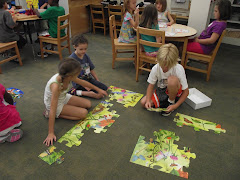It is Spring Break time. Find your location on the map, drag yourself to the location, and share with us where you are and what you are doing. Please remember to use only your first name and last initial, make sure an adult is aware that you are blogging! We can't wait to read about your Spring Break Adventures!
View Larger Map
Thursday, March 31, 2011
Celebrating Women In History Month
During the month of March our Second Grade Class spent time researching and writing about women that have made extraordinary contributions in history! Please enjoy the VoiceThread and we look forward to reading your comments in morning meeting.
Publish Post
Wednesday, March 23, 2011
Blogging Rules
1. Do not include your entire last name or any personal information. Please use your last initial. Parents, a great way to identify yourself is by using your child’s name; for example: “Jacob’s mom.” Never give out your address or phone number in your posts or comments.
2. Check your post for spelling errors, grammar errors, etc. Once you submit your comment or post, it cannot be changed.
3. Use appropriate language. Remember that everything you put on the web can be seen by lots of people. Be sure that you are proud of everything you write. Do not write anything that could hurt someone’s feelings or embarrass you later.
4. Show you're thinking, and encourage others to refine their thinking. Instead of writing, “Your post was so cool, dude,” try to express yourself more clearly. If you think a post was cool, try to tell why it was so amazing. Don’t be afraid to ask questions!
5. Remember that all comments have to be approved before they are posted to the blog. If your comment or post does not appear right away, please do not send it again. Tammy will review all comments and posts before posting them, so remember to make wise choices. Let’s be amazing digital citizens.
2. Check your post for spelling errors, grammar errors, etc. Once you submit your comment or post, it cannot be changed.
3. Use appropriate language. Remember that everything you put on the web can be seen by lots of people. Be sure that you are proud of everything you write. Do not write anything that could hurt someone’s feelings or embarrass you later.
4. Show you're thinking, and encourage others to refine their thinking. Instead of writing, “Your post was so cool, dude,” try to express yourself more clearly. If you think a post was cool, try to tell why it was so amazing. Don’t be afraid to ask questions!
5. Remember that all comments have to be approved before they are posted to the blog. If your comment or post does not appear right away, please do not send it again. Tammy will review all comments and posts before posting them, so remember to make wise choices. Let’s be amazing digital citizens.
Saturday, March 19, 2011
Japan...
March 16, 2011
Japan's Nuclear Fears
More trouble takes hold of the Asian nation after a strong quake and powerful waves caused deadly destruction last week
By Jonathan Rosenbloom and Kelli Plasket
The effects of the massive earthquake and tsunami that struck Japan last Friday are still playing out at Japan's nuclear power plants. Nuclear reactors at Japan's Fukushima Daiichi nuclear plant are experiencing cooling problems after the tsunami waves knocked out the plant's power and backup power.
KYODO NEWS/AP
People with empty jugs walk through a damaged neighborhood in Kesennuma, Japan, in search of fresh water. Water and food supplies are low following Friday's massive earthquake and tsunami.
On Monday morning, an explosion occurred at the Fukushima Daiichi plant that blew off the roof of one of the buildings. Some radiation—energy that can be harmful at high levels—has been released into the air as efforts continue to shut down the reactors. Two of the three reactors that were operating when the quake struck have since been damaged. Cooling problems at the reactors have led to nuclear fuel overheating and fires, causing fears of a meltdown at the plant. Now, 50 workers are working around the clock to flood the reactors with seawater to cool off the fuel rods.
Fears of radiation exposure in Japan are slowing down recovery efforts from the tsunami. Some 70,000 residents have been evacuated from the 12-mile area around the plant. Another 140,000 people in a 19-mile area have been told to stay indoors. Many outside of the area are heading south, just to be safe. Radiation exposure testing centers have been set up for residents, but authorities believe that most people have not been exposed to high levels of radiation.
A Rippling Effect
The massive earthquake that struck Japan last Friday registered a 9.0 magnitude—upgraded from an original 8.9-magnitude reading by the U.S. Geological Survey. It was the most powerful temblor to hit Japan since officials there began keeping records 140 years ago. Before this, the country's worst earthquake was an 8.3 temblor in 1923. Japan lies on the "Ring of Fire"--an area rimming the Pacific Ocean. About 90 percent of the world's earthquakes take place in that region. With the updated 9.0 reading, Friday's quake ranks as the fourth largest quake in the world since 1900, scientists say.
The center of the quake was located about 17 miles beneath the ocean floor, in a spot 80 miles off the eastern coast of the island nation. "The earthquake has caused major damage in a broad area in northern Japan," Prime Minister Naoto Kan said. This week, millions of people are still without water, food or heat as recovery efforts continued and as new problems arose at the nation's nuclear power plants.
Dozens of cities and villages along a 1,300-mile stretch of coastline were shaken by violent tremors Friday. Because it struck below the Pacific Ocean, the quake set off waves as high as a three-story building. The monstrous waves, called a tsunami (soo-nah-mee), swept away homes, boats and cars as the water roared several miles inland, stopped, and rolled back out to sea. Highways buckled, telephone lines snapped, and fires broke out. Hundreds of aftershocks, or smaller quakes, have followed the big quake, causing more damage and forcing residents to seek safety outside.
Tokyo, Japan's capital, is about 230 miles away from the center of the quake. But even there, people felt the ground shake. Buildings swayed, at least 2 million homes were without electricity, and trains stopped running. "At first it didn't feel unusual, but then it went on and on. So I got myself and my wife under the table," said Jesse Johnson, an American living in Tokyo. "I've lived in Japan for 10 years and I've never felt anything like this before. The aftershocks keep coming. It's gotten to the point where I don't know whether it's me shaking or an earthquake."
Japan's Devastation
The total damage, deaths and injuries won't become clear for days or even weeks. On Wednesday, Japanese officials reported that the death toll has reached more than 3,600, though thousands remain missing. "In the 65 years after the end of World War II, this is the toughest and the most difficult crisis for Japan," Prime Minister Kan said.
A large-scale emergency response operation continues in northern Japan. As of Monday, about 15,000 people have been rescued. A 60-year-old Japanese man floated on a piece of his house's roof for over two days. He was rescued 10 miles offshore Sunday when sailors spotted the man waving a red flag.
Many of the world's nations have offered to assist Japan. President Obama has ordered five Navy ships to head for the island to help, as well as search and rescue teams. Secretary of State Hillary Clinton is closely watching the situation. She promised immediate disaster relief assistance. "We are working closely with the government of Japan to provide additional help," she said in a statement. As the damage becomes clearer, Japan may need all the help it can get.
Second Grade what is happening in Japan at this time is really sad.... but we can help. Please talk about ways with your families to raise money for U.N.I.C.E.F to send to the victims of Japan. Many of us talked about having a lemonade stand, a walk-a-thon, or a chore-a thon. Please share your ideas and lets plan to send some relief soon. We look forward to reading your thoughts and ideas.
Monday, March 14, 2011
Fractions...
We are learning about fractions in math. Can you think of a time when you needed to share something in equal parts? Please blog about it... We look forward to reading your comments in morning meeting. Did you learn anything interesting from the video?
Thursday, March 10, 2011
Meet Our Author of the Month- Patricia Polacco
Please tell us about your favorite Patricia Polacco book. We look forward to reading your comments.
Monday, March 7, 2011
Internation Women's Day- Join Us on the Bridge
Do you think that it is a coincident that National Women's Day is celebrated in March? The same month that women who have made contributions to our world are celebrated. National Women's Day Celebrates for the 100th year Tuesday, March 8, 2011. Watch the youtube video to see how women and men around the world with come together to celebrate women! We look forward to hearing your comments in morning circle. We have many names for you to choose from for your research on the celebration of women.
Friday, March 4, 2011
Tuesday, March 1, 2011
Celebrating Women In History
March will be a very exciting month in our classroom. Many of our classmates are in the TCS Production of Willy Wonka, Saturday, March 5 and Sunday, March 6. We are preparing for our class play Character Matters 2.We will present the play to our families Friday, March 18. We will also read, honor, and celebrate women who have made diverse and historic accomplishments. Please write about a woman that you think should be honored and celebrated. We look forward to reading your post in morning meeting.
Subscribe to:
Posts (Atom)


